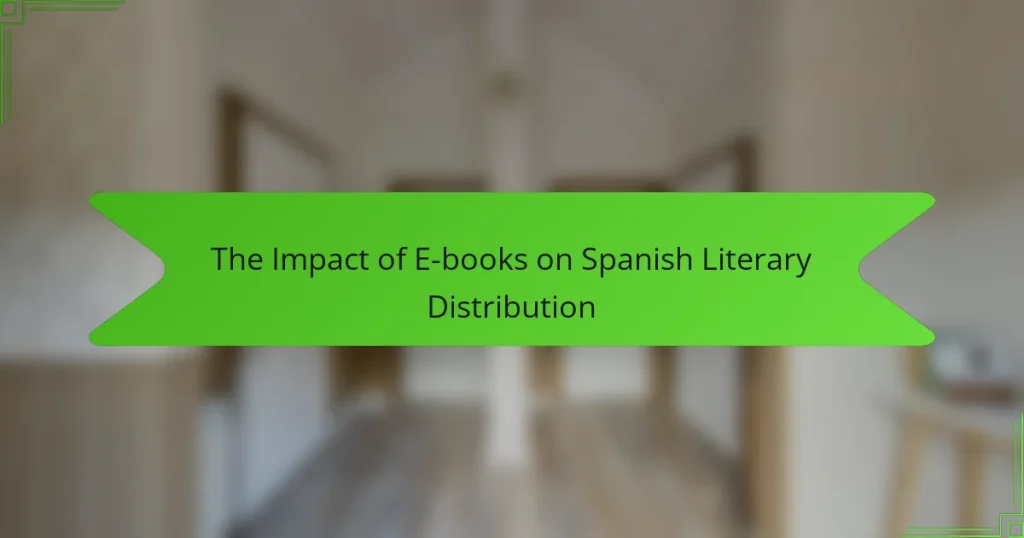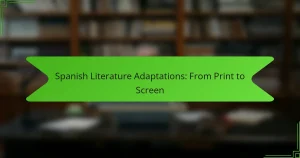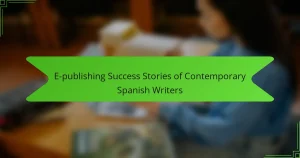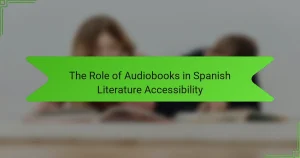E-books are transforming Spanish literary distribution by enhancing accessibility and enabling diverse voices. This article explores the challenges faced by traditional publishers, shifts in reading habits, and the appeal of e-books among consumers. It also examines emerging trends like localized content and subscription models that are reshaping the market.
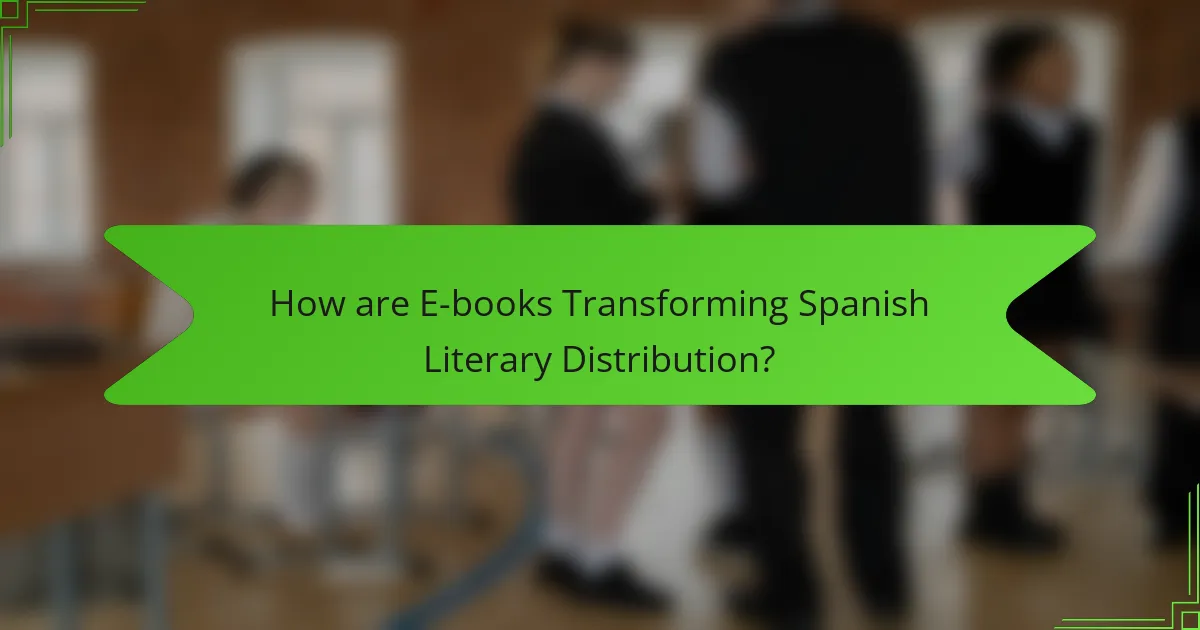
How are E-books Transforming Spanish Literary Distribution?
E-books are revolutionizing Spanish literary distribution by increasing accessibility and broadening market reach. They enable authors to bypass traditional publishing barriers, allowing for diverse voices and genres to emerge. The digital format also reduces production costs, making it easier for independent authors to publish their work. As a result, readers gain access to a wider array of literature, fostering a more inclusive literary culture in Spain.
What are the Key Benefits of E-books for Spanish Authors?
E-books offer significant benefits for Spanish authors, enhancing their literary distribution. They provide wider market access, allowing authors to reach global audiences without geographical limitations. E-books also reduce publishing costs, enabling authors to invest more in marketing and promotion. Additionally, the ease of updating content allows authors to refine their work based on reader feedback. Lastly, e-books facilitate data collection on reader preferences, helping authors tailor future projects effectively.
How Do E-books Affect Reader Accessibility in Spanish-Speaking Regions?
E-books significantly enhance reader accessibility in Spanish-speaking regions by providing affordable and diverse literary options. They eliminate geographical barriers, allowing access to a wider range of authors and genres. E-books often come with adjustable text sizes and background colors, catering to various reading preferences and needs. As a result, readers can engage with literature that may not be available in traditional print formats.
Which Platforms are Leading in E-book Distribution for Spanish Literature?
Amazon Kindle, Apple Books, and Google Play Books are leading platforms in e-book distribution for Spanish literature. These platforms offer extensive catalogs and user-friendly interfaces, enhancing accessibility for Spanish-speaking readers.
Amazon Kindle dominates with its vast selection and subscription services, attracting a large audience. Apple Books provides a curated experience with a focus on quality content, while Google Play Books enables easy access across devices.
Emerging platforms like Scribd and Kobo are also gaining traction, offering unique features such as subscription models and community engagement. These platforms contribute to the growing landscape of Spanish literary distribution in the digital age.
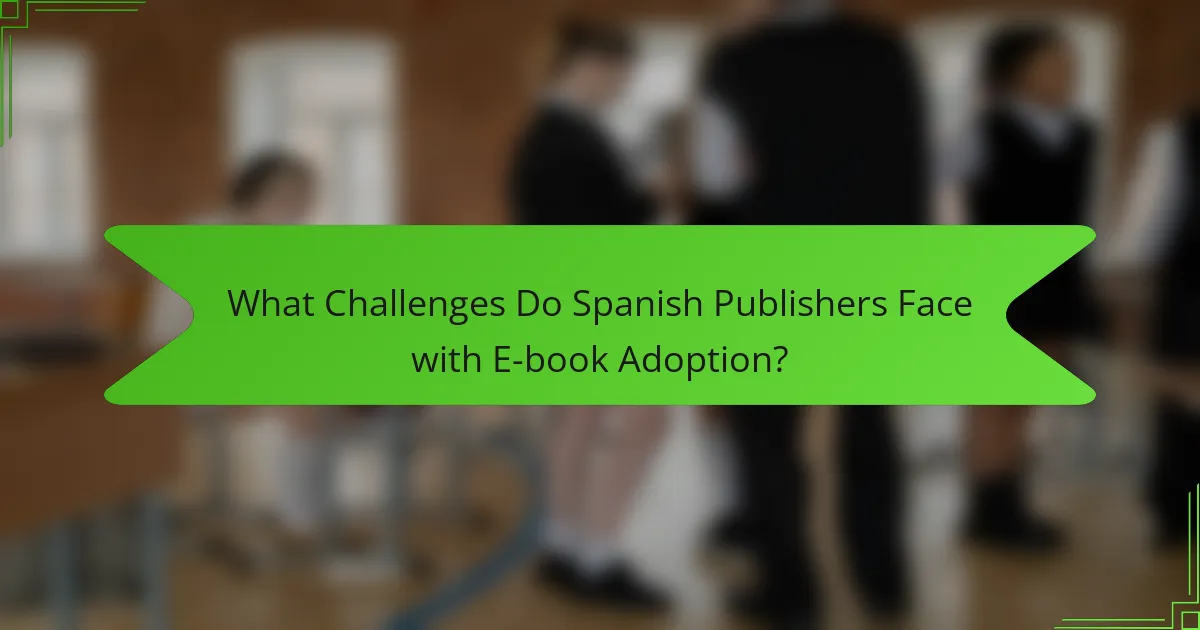
What Challenges Do Spanish Publishers Face with E-book Adoption?
Spanish publishers face significant challenges with e-book adoption, including market competition and technological barriers. The rise of self-publishing platforms has intensified competition, making it harder for traditional publishers to maintain market share. Additionally, many publishers struggle with the technical aspects of e-book formatting and distribution, which can hinder their ability to reach a broader audience.
Moreover, consumer preferences for physical books remain strong in Spain, limiting the e-book market’s growth. Publishers also encounter issues related to copyright management and pricing strategies, which complicate their e-book offerings. As a result, these challenges create a complex landscape for Spanish publishers navigating the digital literary distribution.
How Do Copyright Issues Impact E-book Distribution in Spain?
Copyright issues significantly hinder e-book distribution in Spain by limiting access to digital content. Authors and publishers face challenges in protecting their intellectual property, which affects the availability of e-books. Enforcement of copyright laws can restrict the distribution channels, leading to reduced market reach. As a result, many potential readers may not access a wide array of literary works. The balance between protecting creators and ensuring availability remains a complex issue in the digital landscape.
What are the Common Technical Barriers for E-book Publishing?
Common technical barriers for e-book publishing include formatting issues, copyright concerns, and compatibility across devices. Formatting challenges arise from the need to convert manuscripts into various e-book formats like EPUB and MOBI. Copyright issues can complicate the distribution of works, especially in translation. Compatibility varies among e-readers, limiting access to certain titles. These barriers can hinder the growth of Spanish literary distribution in the digital market.

How Do E-books Influence Reading Habits Among Spanish Speakers?
E-books significantly influence reading habits among Spanish speakers by enhancing accessibility and promoting diverse literary content. The digital format allows readers to access a broader range of genres and authors, including those from underrepresented communities. As a result, e-books facilitate a more inclusive literary culture, encouraging exploration beyond traditional print offerings. Additionally, the convenience of e-books supports increased reading frequency, particularly among younger audiences who prefer digital devices. This shift is reshaping the landscape of Spanish literary distribution, making literature more available and appealing to a wider audience.
What Trends Are Emerging in E-book Consumption in Latin America?
E-book consumption in Latin America is increasingly shaping Spanish literary distribution. The rise of digital platforms has facilitated broader access to diverse literary works. E-books allow for instant distribution, reducing costs associated with traditional publishing. As a result, independent authors gain visibility, promoting a richer literary landscape. Additionally, mobile devices play a crucial role, with over 50% of users accessing e-books via smartphones. This trend indicates a shift towards more accessible and varied reading experiences across the region.
How Do E-books Compare to Print Books in Popularity Among Spanish Readers?
E-books are increasingly popular among Spanish readers, often surpassing print books in accessibility and convenience. The rise of digital platforms has transformed literary distribution, making a wide range of titles readily available. E-books offer features such as adjustable text sizes and built-in dictionaries, enhancing the reading experience. A significant factor is the cost-effectiveness of e-books, which tend to be cheaper than their print counterparts. As a result, many Spanish readers prefer e-books for their ease of use and affordability.

Which Unique Attributes of E-books Appeal to Spanish Literature Consumers?
E-books attract Spanish literature consumers due to their accessibility, affordability, and interactive features. These unique attributes enhance the reading experience and expand distribution channels.
Accessibility allows readers to access a vast library of Spanish literature anytime and anywhere, breaking geographical barriers. E-books are often more affordable than print editions, making them appealing to budget-conscious consumers. Interactive features, such as built-in dictionaries and adjustable text sizes, cater to diverse reader preferences, enhancing engagement with the content.
As a result, the unique attributes of e-books significantly impact the distribution and consumption of Spanish literature, fostering a more inclusive literary landscape.
What Role Does Interactivity Play in E-books for Spanish Literature?
Interactivity enhances the engagement and accessibility of e-books in Spanish literature. It allows readers to explore content through features like annotations, hyperlinks, and multimedia elements. These interactive components foster a deeper understanding of cultural contexts and literary themes. As a result, e-books can reach diverse audiences, breaking geographical barriers and promoting Spanish literature globally.
How Do E-book Formats Cater to Diverse Reader Preferences in Spain?
E-book formats significantly enhance reader preferences in Spain by offering flexibility and accessibility. Diverse formats like EPUB, MOBI, and PDF cater to varying device compatibilities and reading habits. For example, EPUB supports reflowable content, making it ideal for mobile devices, while PDF preserves layout for academic texts. This adaptability meets the unique needs of different reader demographics, from students to casual readers. As a result, e-books have transformed Spanish literary distribution, promoting wider access and increased readership across various platforms.
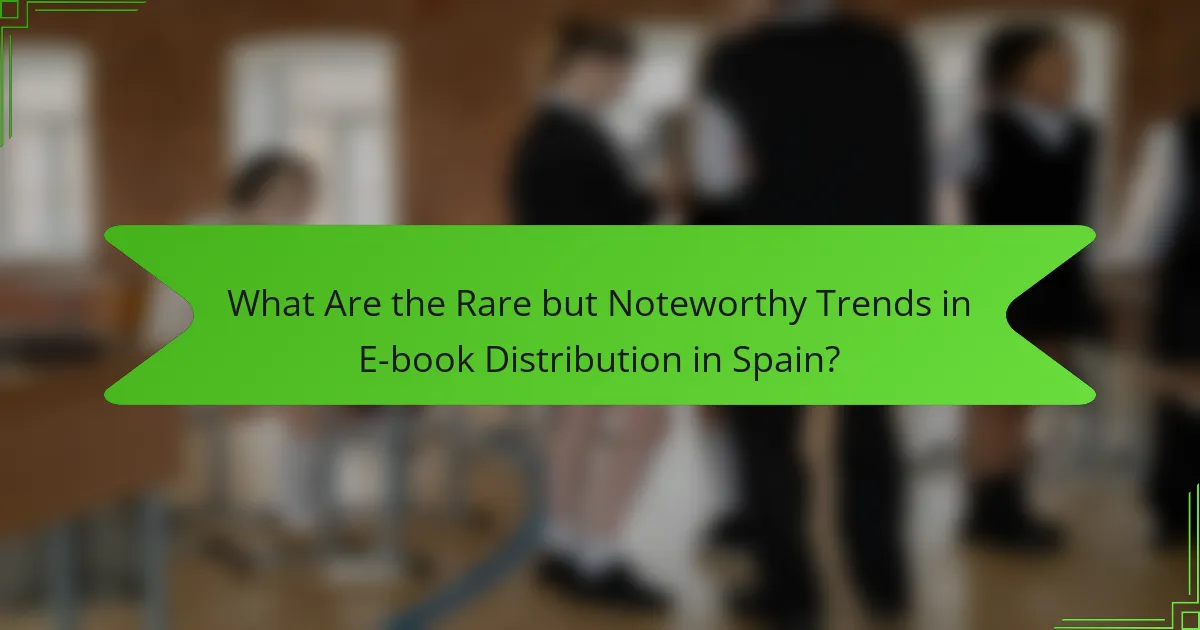
What Are the Rare but Noteworthy Trends in E-book Distribution in Spain?
Rare trends in e-book distribution in Spain include the rise of localized content and subscription models. Localized content caters to regional languages and cultures, enhancing reader engagement. Subscription models are gaining traction, allowing access to vast libraries for a fixed fee, which contrasts traditional purchase methods. Additionally, the integration of augmented reality features in e-books is emerging, providing interactive reading experiences. These trends reflect a shift towards personalization and innovation in the Spanish literary market.
How Are Independent Authors Leveraging E-books for Niche Markets?
Independent authors are using e-books to effectively reach niche markets in Spanish literature. E-books eliminate traditional barriers, allowing authors to publish diverse genres and themes that appeal to specific audiences.
The digital format enables cost-effective distribution, leading to increased accessibility for readers. For example, independent authors can target underserved communities, exploring cultural themes that resonate deeply.
Data shows that e-book sales in Spanish-speaking countries have surged, reflecting a growing demand for localized content. This trend empowers authors to connect directly with readers, fostering a sense of community and engagement.
As a result, independent authors are redefining Spanish literary distribution, creating a vibrant ecosystem that supports niche voices and innovative storytelling.
What Innovative Marketing Strategies Are Emerging for E-books in Spanish Literature?
Innovative marketing strategies for e-books in Spanish literature focus on targeted social media campaigns, influencer partnerships, and personalized content recommendations. These approaches enhance visibility and accessibility, reaching diverse audiences effectively. For instance, leveraging platforms like Instagram and TikTok allows authors to engage with younger readers through visual storytelling. As a result, e-books are increasingly integrated into digital reading communities, fostering a culture of sharing and discussion around Spanish literature.
What Best Practices Should Spanish Authors Follow for E-book Success?
Spanish authors should focus on quality, marketing, and reader engagement for e-book success. Prioritizing high-quality writing enhances reader satisfaction and encourages positive reviews. Effective marketing strategies, including social media promotion and targeted advertising, can significantly increase visibility. Engaging with readers through platforms and feedback fosters a loyal audience. Additionally, understanding digital distribution channels and pricing strategies can optimize sales. Emphasizing these best practices can lead to greater success in the evolving e-book landscape.
